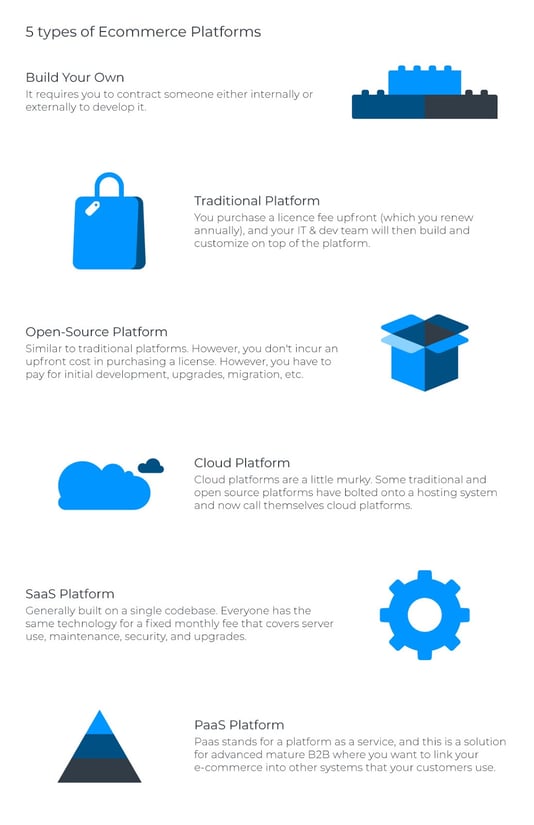%20(1)%20(1)-1.jpg)

Get monthly notifications
The major difference between the most common e-commerce platforms
It’s safe to say that you need a website that will be able to face today’s increasingly growing competition in retail. While qualities such as design and content on an e-commerce platform are of great significance, here’s what ensures your business stands out -
- Customer Engagement
- Lead Generation
- Quality services and processes
These main attributes are the pillars on which you can figure out whether your site is successful in creating ROI (return on investment) or not.
Therefore, selecting the right kind of platform is essential and we’re here to help you make that decision!
Since there are so many options available, you don’t need to go with the first best platform that you’re introduced to. Allow yourself to seriously consider what your desired goals are and how they fit in with improving your e-commerce website. Do you simply want to increase revenue or do you want to extend your brand name far and wide?
Selecting the right platform for your business is a significant decision, and we’ve outlined them here -

1 Homebuilt
This option requires you to hire someone to build the actual platform in-house. This used to be very common but is now used by only a small percentage of companies.
2 Traditional
You buy a license fee (which is renewed annually) and then let your IT-team customize this platform. The developers and your personnel will then be able to customize on top of the platform and it can later be installed into the cloud. Some traditional platforms to use are Kentico and IBM Digital Commerce.
3 Open-source
This is a similar solution to the traditional platform since it involves the same development procedure. There is no initial cost or a license fee, but you do have other expenses such as upgrades, migration, and implementation. An example of a provider for an open source e-commerce platform is Magento.
4 Cloud
A solution where traditional and open-source platforms are joint in a hosting system that looks pretty different. A lot of cloud-hosted platforms are just legacy platforms that are hosted in the cloud, which means that you still need to work on maintenance and install upgrades. Some examples of cloud-based solutions are Magento Enterprise Cloud and Volusion.
5 SaaS
This platform is usually built on a single code-base and for a fixed monthly fee, the following are included -
- Maintenance
- Security
- Server Use
- Upgrades
With SaaS, you’re not required to maintain either the cloud-based hosting provider or a physical server. Just as the traditional option, it’s a licensed product but paid for monthly instead of annually and hosting is included.
The advantage with SaaS is the fact that it’s a quick setup, but there can be substantial monthly fees linked to transaction volumes. The more you turn, the higher your SaaS fees will be. Some SaaS providers include Oracle and SAP.
6 PaaS
PaaS stands for a Platform as a Service, and this is a solution for advanced mature B2B’s where you want to link your e-commerce into other systems that your customers use, like SAP and Ariba. B2B clients can link their purchasing systems straight into your B2B e-commerce. This is vital if you are selling into large companies that have complex procurement systems that they process their purchase orders through. PaaS has extensive API and continuous fees. Some PaaS providers are AWS Elastic Beanstalk and Google App Engine.
5 things to keep in mind when choosing a solution
It’s always wise to keep the future in mind, and even if the cheapest or the simplest solution might seem reasonable right now – you have to ask yourself whether it’s the best option in the long run?
You need to weigh in how important it is for you to have full control over everything and what you want to achieve.
Open-source is for those who want to have complete control and a lot of flexibility. A great thing with open-source platforms is that they generally adapt quickly to new trends, and bug fixes are usually also quickly available and free.
If you need more security and feel the need of having support available, you should instead choose a licensed product. Focus on -
1) Pricing
Regardless of the size of your e-commerce, you need to consider the costs. The costs vary depending on the platform but almost all platforms have a monthly fee. If there is a contract, how long is it and what would it cost if you have to cancel the contract early?
2) Customer service
Some common issues related to e-commerce are server downtime and the need for continuous updates and new software installations. A crash can affect your revenue and if the downtime is substantial – also to your brand image. So look into the various platform’s customer service to see what kind of support is available and at what hours during the day.
3) Tools and plugins
When you’re trying to decide on which platform to choose, many of them will have a lot of different available tools. Try to figure out what tools you need and which ones you’re already using. Some plugins you need are accounting plugins, email marketing tools, customer rewards system and apps in relation to shipping.
4) Security & fraud
You need to look for a platform with a clear focus on security for your customers, which will help you prevent fraud. You also want to make sure that the platform integrates with payment gateways like PayPal and Authorize.net. Make sure that your platform supports HTTPS/SSL and that the platform is PCI (Payment Card Industry) compliant.
5) User experience
Today you want to choose a platform that is tablet and mobile-friendly. Your customers need to be able to easily access your website and make purchases from their mobile devices. It’s also important to consider things such as: Can you search by keyword or category? How many steps are included when you’re purchasing something? But also make sure just to look for features you really need.
Choose a platform that you can scale to your ideal business size and don’t have another, much larger business in mind, because then you will only end up paying way too much money for features you’ll never end up using.
We’ve written a lot of tips for e-commerce companies, like these:
- High-level guide to marketing for e-commerce
- How to create an extraordinary on-site experience for your e-commerce
Keywords: e-commerce, SaaS, PaaS
Sources: https://www.coredna.com/blogs/best-ecommerce-platform
https://www.willows-consulting.com/types-of-ecommerce-platforms/
https://searchenginewatch.com/2017/08/11/7-things-to-consider-when-choosing-an-ecommerce-platform/
https://www.revolutionparts.com/wp-content/uploads/2015/06/Platform-Evaluation-Checklist.pdf
Featured Articles
The Full Funnel Approach and Pinterest
Today, we're going to delve into the significance of working with a full-funnel strategy and understanding why a comprehensive media mix is crucial. We'll also explore an example of how this approach and including Pinterest in the media mix led to a significant decrease in the cost of sales for Houdini.
Master Text Overlays: Boost Ad Engagement
In recent years, capturing the attention of your target audience has become more challenging than ever. Businesses and marketers are constantly on the lookout for innovative ways to stand out in the crowded advertising landscape.
One effective technique to draw attention to your ad's message is through the use of text overlays on image and video ads. In this blog, we will explore the best practices for incorporating text overlays, ensuring your message is impactful without compromising the visual appeal of your ads.
Similar Articles
Protect Your Facebook Business Account from Phishing: Expert Tips by Keywordio
Hello everyone, Johan here from Keywordio. Today, I want to share crucial insights into phishing—what it is and how you can safeguard your Facebook business account from this prevalent threat.
Exploring the Future of TikTok: Insights from the 2024 Trend Report
Introduction
I'm excited to delve into TikTok's comprehensive "What's Next 2024 Trend Report." This report is a treasure trove for anyone in digital marketing, offering deep insights into the future of content, storytelling, and consumer engagement on TikTok.
E-Commerce Excellence: Meta's Advantage+ Shopping Campaigns Redefined
Welcome to the dynamic world of e-commerce, where Meta's Advantage+ shopping is reshaping how businesses connect with customers. In this blog post, we'll explore the key features of this innovative tool.
Introducing TikTok Shop
Today, I bring to your attention a revolutionary update from TikTok, a platform where over 150 million Americans seek daily doses of inspiration and entertainment. With a plethora of trends, fashion hacks, beauty nuggets, and a smattering of recipes, TikTok has emerged as a modern-day oracle for curious minds. The excitement in the air thickens as we unveil TikTok Shop to the US, an avant-garde conduit for folks to spot and snag their adored items seamlessly.
The Full Funnel Approach and Pinterest
Today, we're going to delve into the significance of working with a full-funnel strategy and understanding why a comprehensive media mix is crucial. We'll also explore an example of how this approach and including Pinterest in the media mix led to a significant decrease in the cost of sales for Houdini.
Master Text Overlays: Boost Ad Engagement
In recent years, capturing the attention of your target audience has become more challenging than ever. Businesses and marketers are constantly on the lookout for innovative ways to stand out in the crowded advertising landscape.
One effective technique to draw attention to your ad's message is through the use of text overlays on image and video ads. In this blog, we will explore the best practices for incorporating text overlays, ensuring your message is impactful without compromising the visual appeal of your ads.
The Next Big Thing: 5 Digital Marketing Trends to Watch for in 2023
Digital marketing is a constantly evolving field, shaped by emerging technologies, changing consumer behaviors, and the dynamic nature of the online landscape. Staying on top of the latest trends is crucial for businesses and marketers to effectively engage with their target audience and drive growth. In this introduction, we will explore some of the key digital marketing trends that have emerged in recent times.
The Power of Branding on Meta
Are you ready to unlock unparalleled opportunities and take your online business to new heights? In a rapidly evolving digital landscape, Meta continues to revolutionize the way marketers and entrepreneurs create an impact on buyers.
Today, we will talk about the immense potential of branding on Meta's platforms, Facebook and Instagram based on our Meta Branding (Online Course). Brace yourself for insights that will empower you to establish a strong brand identity, harness consumer trends, and optimize your advertising strategies like never before! Ready to spearhead your business to success? by understanding the potential of branding on Meta and how you can tap into it. Excited? So are we - let's get into it!
A Sneak Peek into Pinterest's 2023 Product Updates!
Pinterest is improving its Ads Manager to provide a seamless experience for advertisers. New features will be released throughout 2023 to optimize advertising strategies. Pinterest aims to offer powerful tools and insights for better campaign results. Get a sneak peek into the exciting updates coming to Ads Manager this year.